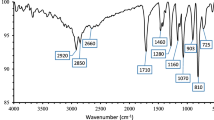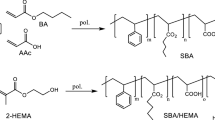Abstract
Poly(styrene-co-acrylic acid) (St/AA) latices were prepared by using a batch soap-free emulsion copolymerisation in non-buffered medium. Polymerisation kinetics, followed by gravimetric method, revealed that increasing AA comonomer concentration was directly proportional to the copolymerisation rate, while adding AA comonomer caused a strong decrease of particle size of final St/AA latex particle without affecting the size distribution. Transmission electron microscopy indicated that the particles were monodispersed and spherical in shape irrespective of AA amount used in the investigated range. The colloidal stability of the latices was increased upon increasing the AA concentration; owing to the electrosteric stabilisation originated from AA-rich layer on the particle surface. In addition, electrophoretic mobility of formed particles versus polymerisation conversion exhibited the constancy of the surface charge density during the polymerisation process and was inferred for discussion of the polymerisation mechanism of this system.









Similar content being viewed by others
References
Kawaguchi H (1993) In: Tsuruta T, Hayashi T, Kataoka K, Ishihara K, Kimura Y (eds) Biomedical applications of polymeric materials. CRC press, Boca Raton, FL, pp 299–324
Lee CF, Young TH, Huang YH, Chiu WY (2000) Polymer 41:8565
Elaissari A, Rodrigue M, Meunier F, Herve C (2001) J Magn Magn Mater 225:127
Ortega-Vinuesa JL, Bastos-Gonzalez D (2001) J Biomater Sci Polymer Edn 12(4):379
Molina-Bolivar JA, Galisteo-Gonzalez F (2004) In: Elaissari A (ed) Colloidal biomolecules, biomaterials, and biomedical applications. Marcel Dekker, Inc., New York, pp 53–101
Ganachaud F, Sauzedde F, Elaissari A, Pichot C (1997) J Appl Polym Sci 65:2315
Lui Z, Xiao H (2000) Polymer 41:7023
Shoaf GL, Poehlein GW (1991) J Appl Polym Sci 42:1213
Wang ST, Poehlein GW (1993) J Appl Polym Sci 50:2173
Slawinski M, Meuldijk J, Van Herk AM, German AL (2000) J Appl Polym Sci 78:875
Wang PH, Pan CY (2001) Colloid Polym Sci 279(1):98
Wang PH, Pan CY (2002) Colloid Polym Sci 280(2): 152
Long JA, Osmond DWJ, Vincent B (1973) J Colloid Interface Sci 42(3):545
Fitch RM (1997) Polymer colloids: a comprehensive introduction, Academic Press, New York, pp 8
Tauer K, Kuhn I (1995) Macromolecules 28:2236
Kuhn I, Tauer K (1995) Macromolecules 28:8122
Odian G (1991) Principle of polymerization, 3rd edn. John Wiley, New York, pp 335–348
Schild RL, El-Aasser MS, Poelhein GW, Vanderhoff JW (1978) In: Becher P, Yudenfreund MN (eds) Emulsion latexes and dispersions, Marcel Dekker, New York, pp 99–128
Liu LJ, Kriegger IM (1981) J Polym Sci Polym Chem Ed 19:3031
Delair T, Pichot C, Mandrand B (1994) Colloid Polym Sci 272(1):72
Delair T, Marguet V, Pichot C, Mandrand B (1994) Colloid Polym Sci 272(8):962
Feeney PJ, Napper DH, Gilbert RG (1984) Macromolecules 17: 2520
Huheey JE (1978) Inorganic chemistry. Harper & Row, New York, pp 846
Lock MR (1989) Preparation and characterization of acrylate latexes containing dicarboxylic acid comonomers, Ph.D. Thesis, Lehigh University
Vanderhoff JW, van den Hul HJ (1973) J Macromol Sci Chem 7(3):677
Zwetsloot JPH, Leyte JC (1994) J Colloid Interface Sci 163:362
Bastos-Gonzalez D, Hidalgo-Alvarez R, De Las Nieves FJ (1996) J Colloid Interface Sci 177(2):372
Furusawa K (1982) Bull Chem Soc Jpn 55:48
Santos AM, Elaissari A, Martinho JMG, Pichot C (2004) Colloid Polym Sci 282:661
Hunter RJ (1981) Zeta potential in colloid science principles and applications. Academic, London, pp. 335
Hiemenz PC, Rajagopalan R (1997) Principles of colloid and surface chemistry, 3rd edn. Marcel Dekker, New York
Acknowledgements
Research grant from The Thailand Research Fund (TRF) to P.T., scholarships to D.P. under the TRF Golden Jubilee Ph.D. Program and French Embassy in Thailand are gratefully acknowledged. The authors thank the BioMérieux Company for research support through the chemicals and equipments. Finally, we would like to express sincere gratitude to Dr. Christian Pichot and Dr. Jhunu Chatterjee for fruitful discussions, comments and suggestions.
Author information
Authors and Affiliations
Corresponding author
Rights and permissions
About this article
Cite this article
Polpanich, D., Tangboriboonrat, P. & Elaïssari, A. The effect of acrylic acid amount on the colloidal properties of polystyrene latex. Colloid Polym Sci 284, 183–191 (2005). https://doi.org/10.1007/s00396-005-1366-6
Received:
Accepted:
Published:
Issue Date:
DOI: https://doi.org/10.1007/s00396-005-1366-6




